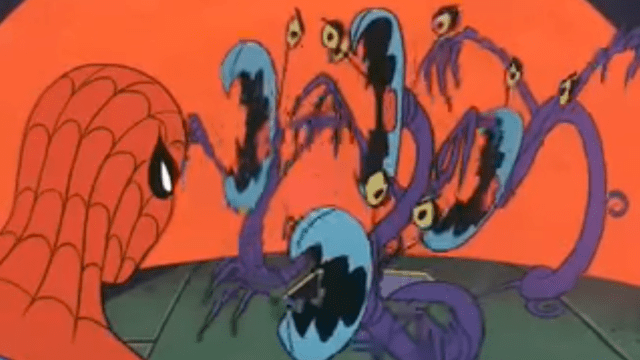What makes a Worst Episode Ever? A total absence of fun? Anything resembling a coherent plot? An inability or perhaps unwillingness to honour its source material? Low-quality production? Should it be so bad it’s good, or should it hurt you with its badness? The answer, I think, can be any of these — which is why choosing the worst episode of the classic 1967 Spider-Man animated series has been so tough.
In “Horn of the Rhino,” Spidey is outwitted (frequently!) by the dimwitted super-villain and inexplicably webs himself into a literal ball to escape some cops. In “Revolt in the Fifth Dimension,” Peter basically goes through a Hunter S. Thompson drug nightmare courtesy of a bunch of tiny aliens. And in the third season, there are multiple episodes that re-use old footage to retell first season episodes, only worse and more boring. What I’m saying is, many of the Spider-Man ’67 episodes are terrible in different ways but usually to the same degree.
But, for some reason, “Vine” stuck out to me, in which Peter Parker unwittingly lets an ancient plant-monster loose in New York and heads three million years in the past to find a ludicrous and moronic solution to the problem. The episode begins with Peter and his girlfriend of the week Jackie (seriously, he ran through multiple love interests in the cartoon; Mary Jane only shows up in a single episode) are rooting around the attic of a house previously belonging to a Professor Smithers. Among his crap and junk are three items of note: a large seed, a journal, and a permanently open time portal to 3,000,000 BC.
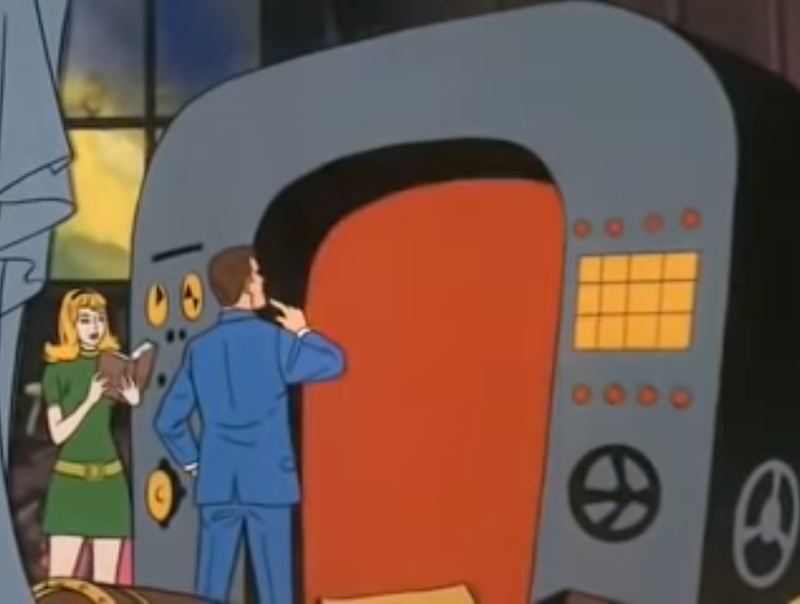
Peter immediately exposes the seed to the light, and it grows into a giant vine monster that crawls out the window and makes a beeline to NYC, leaving a wide swath of destruction in its path (including a blue-white house it crushes not once, but three or four times, to keep animation costs to an absolute minimum). Jackie reads the journal and discovers the Professor is chilling in the past. Peter, with a truly wild jump of illogic, decides the best way to stop the vine creature is by ignoring the last three million years of human advancement, technology, and weaponry, and the fact that he’s Spider-Man by deciding to leap through the time portal and find a solution there.
An interesting thing about this classic cartoon is that Spidey is constantly being owned by his various foes, who are led by a powerful villain I like to call “Total Lack of Continuity.” So I want to break down what happens immediately after ol’ Web-head arrives in the past and discovers a giant frog monster:
- Spider-Man fires his webbing at the beast, who has not made any menacing moves toward him.
- The frog, having apparently jumped into the air while off-screen, is webbed and inexplicably frozen in mid-air.

- Suddenly on the ground and free, the frog smacks an attacking Spider-Man so hard he flies on a 30.48 m cliff.
- The frog approaches Spider-Man, who is now somehow caught in a tree at the frog’s eye level.
- Spider-Man webs the frog again, and this time it works for some reason.
- Spider-Man is immediately brained by a blue giant who somehow sneaks up on him. Spidey’s Spider-Sense does not go off at any point during this.
Said blue giants are apparently pals with Professor Smithers, and they bring Spider-Man to him. When the hero warns Smithers that the seed has sprouted and gotten loose, the Professor has the gall to say, “I was afraid of that.” Well, then maybe you shouldn’t have left it in the 20th century in a shoebox in your attic, idiot.
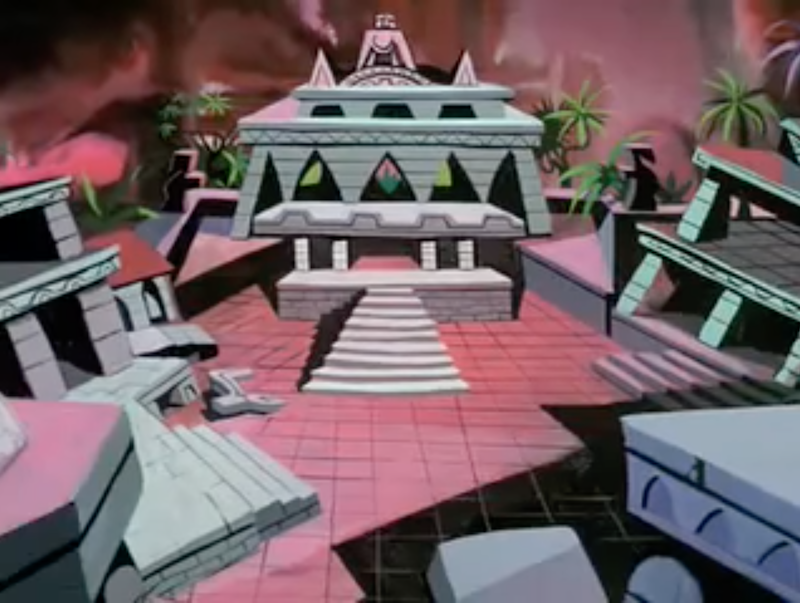
Luckily, the Professor knows how to stop the creature: radium! Unluckily, radium is hard to come by, as he explains in his back story: Smithers brought “all the men he could find” to build a great city in 3,000,000 BC. The vine creatures were there, too, but he discovered they could be destroyed by large gems of radium, which were also used up in the process. By the time the vines were destroyed, only two gems were left, of which the prof says, “we put in the eyes of the large idol we built.” (We will absolutely come back to this in a minute.) Alas, the radium that killed the vines for some unknowable reason then started mutating them into sentient beings who eventually took back over the city and kicked Smithers out. Now they require the energy from the two remaining gems in the idol to live.
When Spider-Man approaches the city, he deduces the idol must be in the giant temple (Batman’s title as World’s Greatest Detective remains thoroughly unchallenged). Spidey is attacked by several plant people, one of whom throws a trident through his web, causing the hero to fall maybe 15.24 m to the ground where he lands directly on his back. Suffice it say, there was no spider-sense alert, nor did it occur to Spidey to, you know, shoot another web. Spider-Man wakes up in an arena where he’s “forced” to fight a monster he could easily swing away from, then he grabs the radium gems and runs, leaving the city littered with the dead bodies of all the plant people.
Meanwhile, here’s what the giant vine monster’s been up to:

So, yeah, it’s not going well. But Spider-Man swings through the portal — I mean, literally, he swings through the portal with his webbing passing impossibly through both sides of the time machine’s frame, the far side of which opens into a house attic that impossibly doesn’t break Peter’s momentum or arc whatsoever — and promptly shoves the gems down the monster’s throat. This, bizarrely, electrocutes the plant creature before killing it. The episode ends with no mention of the tens of thousands of fatalities the vine thing must have caused during its rampage. However, the next day at school, Jackie mentions that somehow the professor’s journal disappeared, and the time portal stopped working, not so much wrapping up loose ends as lazily letting them fall separately to the ground.
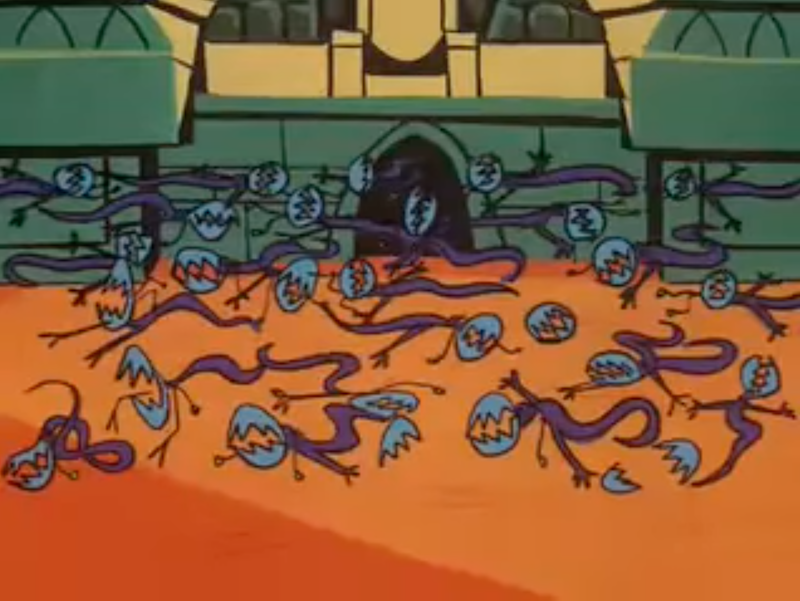
None of this adequately describes how visually bad the Spider-Man cartoon works. Sure, a lot can excused, because the budgets for TV cartoons were usually quite low back then, and most of them were forced to frequently reuse sequences to save money. But Spider-Man has maybe three or four swinging animations, which is a real problem when webslinging makes up probably a full quarter of the episode’s runtime. It also doesn’t excuse how the backgrounds aren’t made to accommodate these animations in the slightest; Spider-Man never seems to actually be a part of the world because his webs are clearly attached to nothing. He never looks like he’s standing properly on the ground in the few times he’s not swinging around.
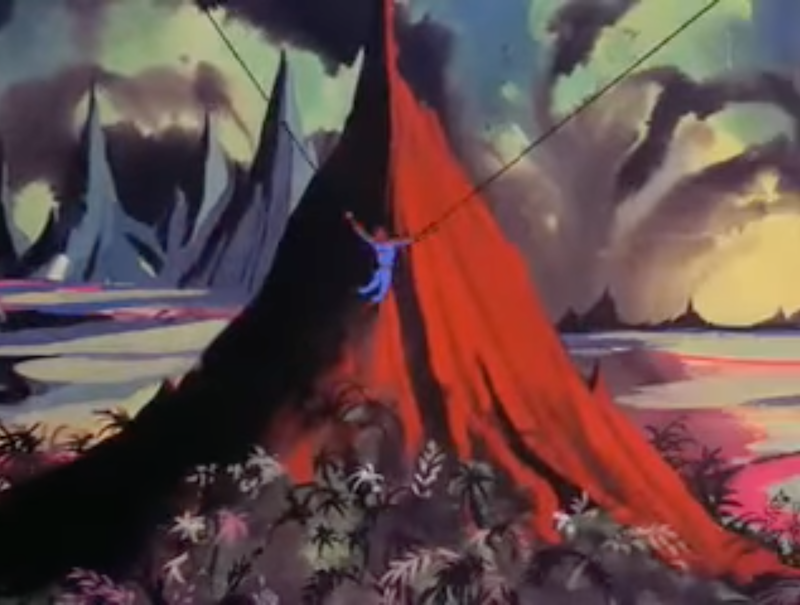
But at least there are budgetary excuses for the animation being terrible — the plot has none. It’s senseless that the McGuffin, the radium, kills the plant creatures, then somehow mutates them, then becomes the only thing keeping them alive. It’s even more absurd that some random NYU professor built a time portal, decided to make an entire city millions of years in the past with his pals, became besties with a few blue giants, got kicked out of his own city by plant people, and then just hung around waiting for…what? The off-chance that some hero will eventually root around in his attic? Calling the story illogical feels like an understatement. It’s so lazy it’s practically contemptuous, especially when so much of the run-time of “Vine” is still padded out beyond this nonsense.
The one good thing about this lazy storytelling is that it gives us a golden opportunity to explore the space ourselves, particularly in regard to what in the living fuck Professor Smithers was actually doing. What kind of man would go back in time three million years to create a giant city? Who would volunteer to help with such a project? Why would that city include a massive temple housing an enormous, monstrous idol? Because Smithers very specifically says “we put [the radium gems] in the eyes of the great idol we built.” And the screenshot unequivocally shows people worshipping it before the plant-beings attack:
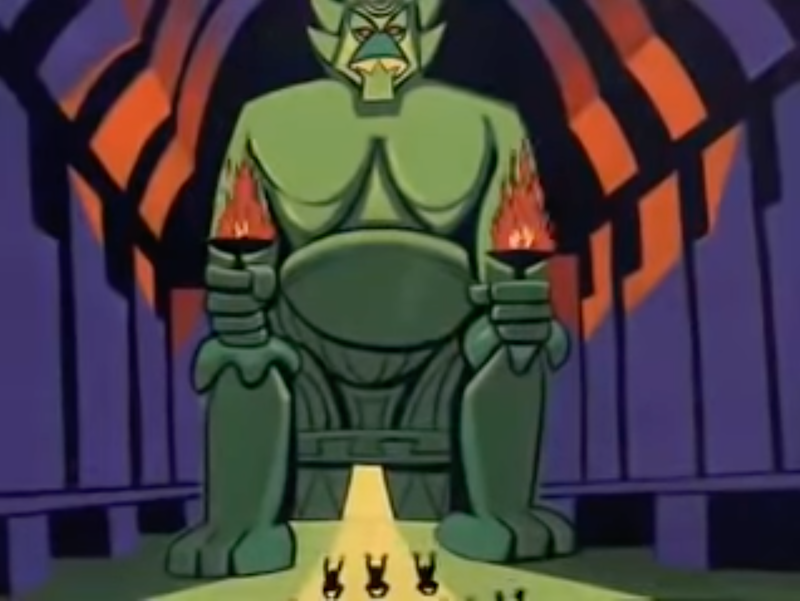
And why, oh why, would the door to the city need to be this big? Who’s going to come through it?
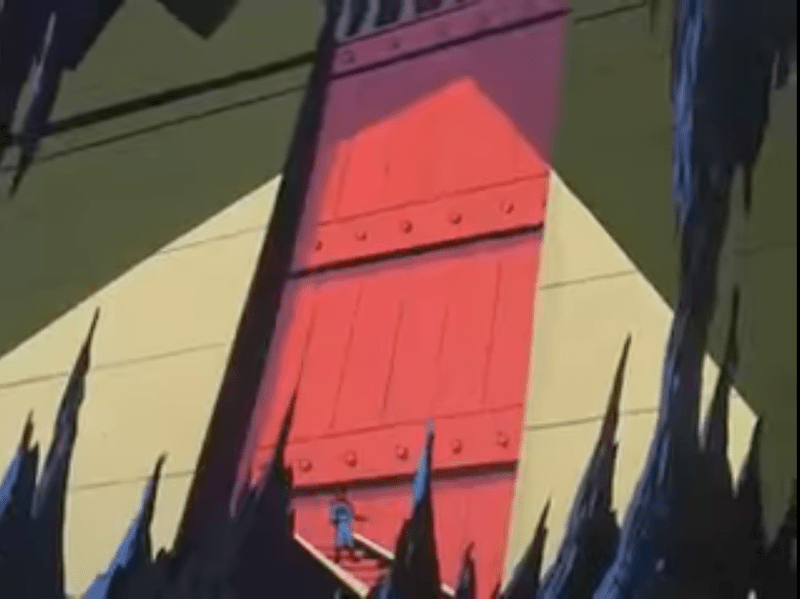
Guys, there’s literally only one reason someone who do this, and it’s because he’s a worshipper of an H.P. Lovecraft-esque, Cthulhu-style Elder God and is trying to summon this unfathomable monster beyond space and time to bring the world to utter ruination before the scourge of humanity ever exists. It’s the only answer that makes a modicum of sense, and I say that without any exaggeration. Smithers and his fellow cult members didn’t go back in time to create a giant temple and pray before a dark idol for their health. They had a goal, and that goal was unspeakably evil.
Of course, if “Vine” had made any of these things explicit, it might have gone down as the greatest episode of the 1967 Spider-Man that ever existed. Alas, it did not. Feel free to enjoy it and the rest of the cartoon for its old-school charm, its extreme campiness, or just ironically. Just know when you do, Professor Smithers’ power grows and the dread god beyond inches ever closer to our world.
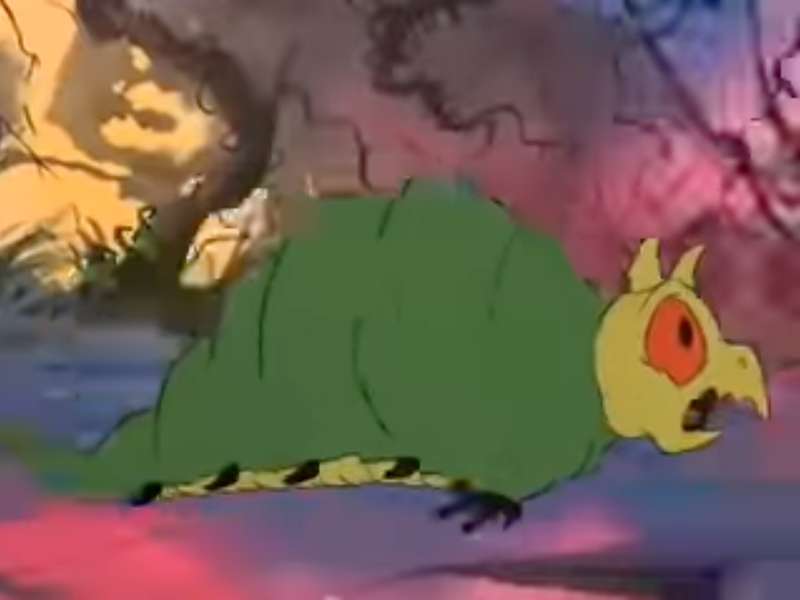
Assorted Musings:
- The second monster Spidey fights in the past looks incredibly anxious, and it’s a little adorable.
- On the way to the city, Spidey encounters another monster and runs into a giant chasm he cannot cross. Hard cut to: Spider-Man swinging merrily, the chasm far behind him, his solution to this unsolvable problem unmentioned.
- The plant guys have a plant king, and I will happily confess to smiling when he praised his own “vegetable superiority” and how much he hated looking at Spider-Man’s “protein body.”
- At one point, Spider-Man webs up a large monster and has to tie his webs in a knot around a ring to secure them. If only spider webs were sticky, like the other end of Spider-Man’s webs which are firmly attached to the monster.
- At another point, one of Spider-Man’s webs just explodes when it hits a plant guy.
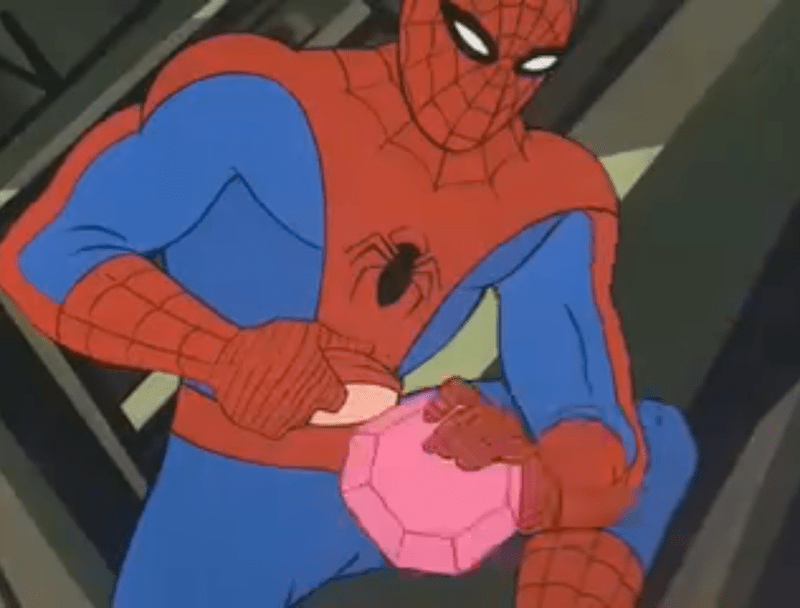
- When Spider-Man steals the two radium gems, which are at minimum three inches thick and have a diameter of one foot, he sticks them both under his shirt where they are apparently placed in the alternate dimension located in his stomach as they are completely unnoticeable.
- The episode ends with Jackie asking Peter to return to the prof’s house and help her “explore the basement,” which isn’t a good sexual euphemism, but certainly could be worse.
